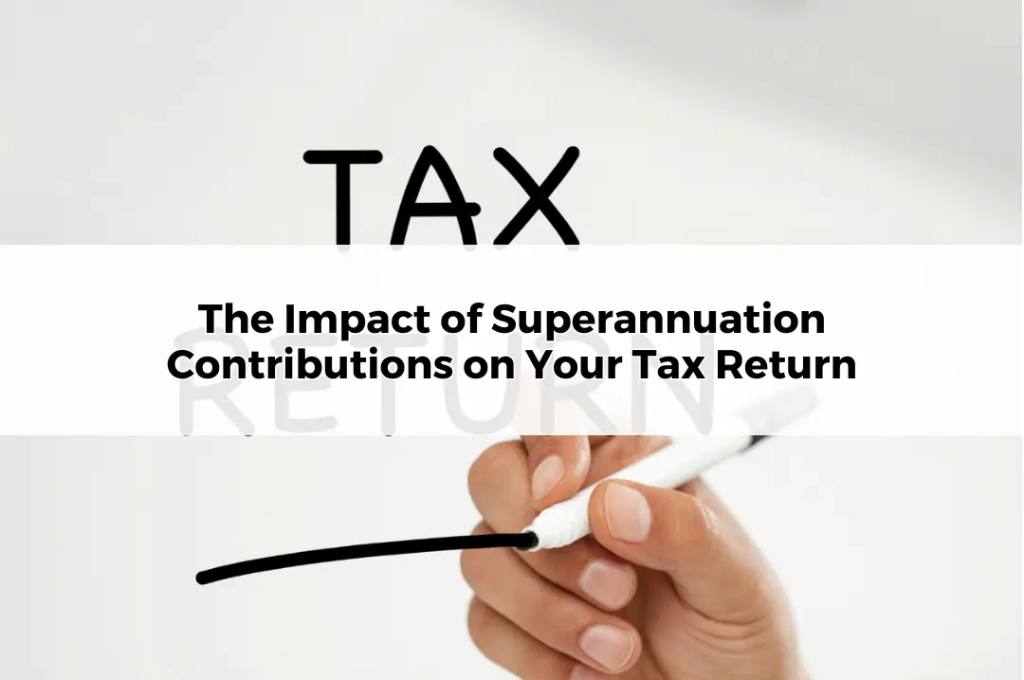The Impact of Superannuation Contributions on Your Tax Return
Table of Contents
ToggleSuperannuation is more than just a retirement savings vehicle; it is also a powerful tool for managing your tax obligations. For Australians, the interplay between superannuation contributions and tax returns can offer substantial financial benefits, provided you understand how the system works. By strategically planning your superannuation contributions, you can not only secure a more comfortable retirement but also optimise your tax outcomes in the present.
The Dual Role of Superannuation in Retirement Planning and Tax Management
Superannuation serves a dual purpose: it provides a tax-advantaged way to save for retirement while offering opportunities to reduce your taxable income today. This dual role makes superannuation a cornerstone of both long-term financial planning and immediate tax management. Understanding how to leverage super contributions effectively is key to maximising these benefits.
Why Understanding Superannuation Contributions is Key to Optimising Your Tax Return
Navigating the complexities of superannuation contributions can be challenging, but it is essential for optimising your tax return. The Australian tax system rewards those who contribute to their superannuation with various tax incentives, but these rewards come with rules and limitations that must be understood and respected. A well-informed approach can significantly reduce your tax liability, while also growing your retirement savings.
The Basics of Superannuation Contributions
What are Superannuation Contributions?
Superannuation contributions are the funds added to your super account, either by you, your employer, or on your behalf, to build up your retirement savings. These contributions can be made in several forms, each with different tax implications. Understanding the different types of contributions is the first step in making informed decisions about your superannuation.
Types of Superannuation Contributions: Concessional vs. Non-Concessional
Superannuation contributions are generally classified into two categories: concessional and non-concessional. Concessional contributions are made from pre-tax income and include employer contributions and salary sacrifice amounts. Non-concessional contributions, on the other hand, are made from after-tax income and do not attract the same tax advantages as concessional contributions. Each type plays a distinct role in your overall tax strategy.
Concessional Contributions and Their Tax Benefits
Understanding Concessional Contributions
Concessional contributions are contributions made to your superannuation from pre-tax income, including the Superannuation Guarantee (SG) from your employer, salary sacrificing, and any additional voluntary contributions you make from your before-tax income. These contributions are taxed at a concessional rate of 15% within the super fund, which is often lower than most people’s marginal tax rate, making them an attractive option for tax savings.
How Concessional Contributions Reduce Taxable Income
The most significant benefit of concessional contributions is their ability to reduce your taxable income. By diverting a portion of your salary into superannuation, you effectively lower the amount of income that is subject to higher marginal tax rates. This reduction in taxable income can lead to substantial tax savings, especially for those in higher tax brackets.
The Role of Salary Sacrificing in Tax Planning
What is Salary Sacrificing?
Salary sacrificing involves arranging with your employer to contribute a portion of your pre-tax salary directly into your superannuation fund. This arrangement not only boosts your retirement savings but also reduces your taxable income, as the sacrificed amount is taxed at the concessional superannuation rate rather than your marginal tax rate.
Advantages of Salary Sacrificing for Tax Reduction
Salary sacrificing can be a highly effective tax planning tool. By reducing your taxable income, you lower your overall tax burden while simultaneously increasing your superannuation balance. Over time, the compounding growth within your super fund amplifies these contributions, enhancing your retirement savings significantly while providing immediate tax benefits.
The Impact of Employer Contributions on Your Tax Return
Understanding the Superannuation Guarantee
The Superannuation Guarantee (SG) is a compulsory contribution that your employer must make into your super fund, currently set at 11.5% of your ordinary time earnings. These contributions are classified as concessional contributions and are subject to the same 15% tax rate within the super fund. Understanding how these contributions affect your tax return is crucial, as they form the foundation of your superannuation savings.
How Employer Contributions Affect Your Taxable Income
While employer contributions do not directly reduce your taxable income, they do count towards your concessional contribution cap. Exceeding this cap can result in additional taxes, so it’s important to monitor your contributions to avoid unintended tax consequences. By managing your total concessional contributions effectively, you can maximise your tax benefits without exceeding the cap.
Non-Concessional Contributions: Benefits and Limitations
What are Non-Concessional Contributions?
Non-concessional contributions are contributions made to your superannuation from after-tax income. These contributions do not attract any tax within the super fund, as they have already been taxed at your marginal rate. While they do not provide immediate tax savings, non-concessional contributions offer a way to boost your super balance beyond the concessional cap.
Tax Implications of Making Non-Concessional Contributions
Although non-concessional contributions do not reduce your taxable income, they are still an important part of superannuation strategy. The earnings on these contributions within the super fund are taxed at the concessional rate, which is typically lower than the tax rate on earnings outside of super. However, it’s important to be aware of the non-concessional contribution cap, as exceeding it can lead to significant tax penalties.
Contribution Caps and Their Tax Implications
Understanding Annual Contribution Caps
The Australian tax system imposes annual caps on both concessional and non-concessional contributions to limit the amount of money you can add to your super each year while enjoying tax advantages. For the 2023-2024 financial year, the concessional contribution cap is $30,000, and the non-concessional contribution cap is $120,000. Staying within these caps is essential to avoid additional taxes.
What Happens if You Exceed Your Contribution Caps?
Exceeding your concessional or non-concessional contribution caps can result in significant tax penalties. Excess concessional contributions are taxed at your marginal tax rate, with a tax offset for the 15% already paid within the super fund. Excess non-concessional contributions may be taxed at a punitive rate of 47%, making it crucial to monitor your contributions carefully.
The Low Income Superannuation Tax Offset (LISTO)
Eligibility and Benefits of LISTO
The Low Income Superannuation Tax Offset (LISTO) is designed to help low-income earners boost their superannuation savings by refunding the tax paid on concessional contributions. If you earn $37,000 or less, you may be eligible for a LISTO of up to $500. This government initiative can significantly enhance the retirement savings of low-income earners by effectively reducing the tax paid on their contributions.
How LISTO Can Reduce Your Tax Liability
LISTO effectively reduces the tax burden on concessional contributions for eligible low-income earners, making superannuation an even more attractive savings vehicle. By taking advantage of this offset, you can boost your super balance without incurring additional tax liabilities, helping to secure your financial future.
Tax Deductions for Personal Superannuation Contributions
Eligibility for Claiming Deductions
Since July 1, 2017, most Australians under the age of 75 can claim a tax deduction for personal superannuation contributions, regardless of their employment status. To be eligible, you must notify your super fund of your intention to claim a deduction using a specific form, and this must be done before you lodge your tax return. Claiming these deductions can significantly reduce your taxable income, making it a valuable strategy for managing your tax liabilities.
How to Claim Superannuation Contributions on Your Tax Return
Claiming a tax deduction for personal superannuation contributions involves submitting a Notice of Intent to your super fund and receiving an acknowledgment. Once you have this acknowledgment, you can claim the deduction on your tax return, reducing your taxable income by the amount of the contribution. This process can provide immediate tax relief while enhancing your retirement savings.
Division 293 Tax: An Additional Tax for High-Income Earners
What is Division 293 Tax?
Division 293 Tax is an additional tax imposed on high-income earners whose combined income and concessional superannuation contributions exceed $250,000 in a financial year. This tax is designed to reduce the tax concessions available to higher-income individuals, levying an additional 15% tax on their concessional contributions.
How High-Income Earners Can Manage Additional Tax on Contributions
For high-income earners subject to Division 293 Tax, careful management of concessional contributions is essential. Strategies such as reducing salary sacrificing contributions or increasing non-concessional contributions can help manage the overall tax burden. Consulting with a financial adviser is crucial for developing a tailored strategy that optimises your tax position while ensuring adequate retirement savings.
The Timing of Contributions and Its Effect on Tax Returns
When to Make Contributions for Maximum Tax Benefit
The timing of your superannuation contributions can have a significant impact on your tax return. Contributions made before the end of the financial year can reduce your taxable income for that year, while delaying contributions may mean missing out on valuable tax benefits. Planning your contributions in advance allows you to optimise the tax advantages available through superannuation.
How Contribution Timing Can Influence Your Tax Strategy
Strategic timing of contributions can help you take full advantage of tax deductions and offsets. For example, making a large concessional contribution just before the end of the financial year can significantly reduce your taxable income, leading to immediate tax savings. On the other hand, spreading contributions throughout the year can help manage cash flow while still providing tax benefits.
Seeking Professional Advice for Superannuation and Tax Planning
The Complexity of Superannuation Tax Rules
Superannuation tax rules are complex and can be difficult to navigate without professional guidance. From understanding contribution caps and eligibility criteria for tax deductions to managing the impact of Division 293 Tax, there are many factors to consider. A financial adviser with expertise in superannuation and tax planning can help you make informed decisions that maximise your benefits.
How a Financial Adviser Can Help Optimise Your Contributions and Tax Outcomes
A financial adviser can provide tailored advice to ensure your superannuation contributions are structured in a way that optimises both your retirement savings and tax outcomes. They can help you navigate the complexities of superannuation, ensure compliance with tax laws, and develop a comprehensive strategy that aligns with your financial goals. For those looking to maximise the benefits of their superannuation contributions, professional advice is invaluable.
Conclusion
Superannuation contributions offer a unique opportunity to simultaneously build your retirement savings and reduce your tax liabilities. By understanding the impact of different types of contributions on your tax return, you can make informed decisions that enhance both your immediate and long-term financial position. Regularly reviewing your contributions and adjusting your strategy as needed is key to maximising the benefits of superannuation.
For individuals looking to optimise their superannuation contributions and tax strategy, expert guidance is essential. Rob Laurie and the team at Wealth Factory in Toowoomba offer personalised financial planning services to help you navigate the complexities of superannuation and tax. To get started on a tailored superannuation strategy that aligns with your financial goals, contact Wealth Factory at 07 4659 5222. Taking proactive steps today can lead to significant tax savings and a more secure retirement tomorrow.









